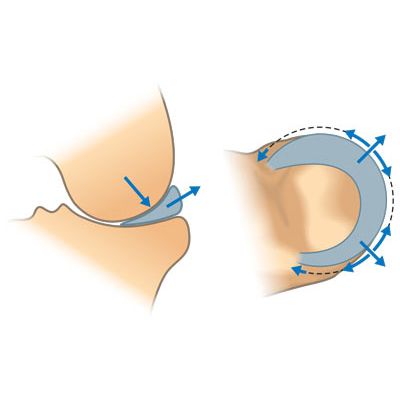


Total Meniscus Replacement Technology
Orthonika`s Total Meniscus Replacement is based on a unique design and proprietary high strength polymers and constructions which replicates not only the bulk macroscopic geometry of the meniscus, but also the underlying microstructure and anisotropic properties affiliated with the real tissue. Orthonika’s ground breaking implant design is unique, in that it features an inherent attachment mechanism incorporated into the underlying microstructure which allows for optimal load transfer and recovery in the knee joint during mobility. Our composite structure allows load redistribution as in the natural meniscus and thus creating a new benchmark for the replacement of load-bearing tissue within a joint. The Total Meniscus Replacement is able to replicate the structure and function of the natural meniscus by mimicking the `hoop stress mechanism` which is key to the correct functioning of the tissue and the preservation of the underlying articular cartilage.
Manufacturing and design of the meniscus replacement are covered by a number of patents. The materials used by Orthonika have well established excellent biocompatibility profiles thus minimizing regulatory risk. The microstructure is impregnated and coated in a proprietary polymer with biphasic material characteristics allowing sophisticated load redistribution and lubrication mechanisms just like the natural tissue.
Usually meniscus injuries occur in the form of a meniscal tears. These can be acute, when the tear is due to trauma and usually consists of a forceful twist or rotation to the knee such as aggressive pivoting, kneeling or deep squatting. Around one third of all meniscal tears are believed to be acute. Tears can also be chronic (degenerative) and these usually occur in older patients when the meniscus has weakened and generally undergone a degeneration in mechanical properties becoming less elastic over time.
How common?
Meniscal tear is the most common knee problem treated surgically with over 1.7 million meniscal injuries in the EU and the US being treated each year. The location and pattern of these tears determines ability of the tear to heal (low or no blood supply in some zones of the meniscus means healing can sometimes be difficult or impossible).
Generally, the medial meniscus is more prone to injury (trauma, sports injuries) compared to the lateral meniscus although lateral meniscectomy is associated with a higher risk of developing tibiofemoral osteoarthritis and a greater rate of cartilage degradation3.
What are the consequences of a meniscal tear?
In the short term, meniscal tears are associated with pain, stiffness, swelling, locking of knee and restricted motion of the knee. In the long term, meniscal tears or partial/complete removal of the meniscus causes a change in knee biomechanics leading to articular cartilage degeneration and ultimately osteoarthritis.
The menisci are two wedge-shaped semilunar discs of fibrocartilaginous tissue. Menisci are functionally a dynamic tissue where they aid in load transmission and distribution, shock absorption, increasing joint congruence and stability, as well as providing lubrication in the joint1 2.
Each knee has two menisci, a medical meniscus and a lateral meniscus. The medial meniscus is located towards the inside of the knee and it has a more distinctive crescent shape than the lateral, which is located on the outside of the knee. Both menisci are attached to the tibia by the meniscotibial ligaments with the medial meniscus also being firmly attached to the medial collateral ligament (the lateral meniscus is not attached to the lateral collateral ligament). This makes the medial meniscus less mobile and more prone to injury compared to the lateral meniscus, especially due to valgus and torsional movements.
The menisci are able to undergo high degrees of loading based on the arrangement of collagen fibres in dense bundles along a circumferential pattern which prevent radial extrusion. Due to its unique wedge-shape, the menisci have a key role in redistributing compressive loads into tensile forces around its circumference, thus reducing contact stresses in the joint and preserving the articulating surface; this is referred to as the `hoop stress mechanism`.
Based on the circumferential orientation of the collagen bundles, the tissue exhibits anisotropic tensile properties as well as demonstrating different zonal organization radiating from the inside-out. The outer edge of the meniscus is referred to as the red (vascular zone) as this is some level of blood supply through small arteries around the joint. The inner edge of the meniscus is referred to as the white zone, given the poor blood supply. For this reason, it is very difficult for the meniscus to heal following injury.
